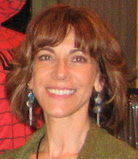It's one thing to talk about how important it is to use local resources in teaching languages. It's quite a bit harder to actually do it. But here's an article I just wrote about one teacher who did just that!
~~~~~~~~~~~~~~~~~~~~~~~~~~~~~~~~~~~~~~~~~~~~~~~~~~~
Monica Lavosky’s Spanish Club students from Montclair High School just got back from a Spanish trip. In the town they visited, they met and conversed with native speakers in Spanish, shopped in local stores, and tasted local foods. Lavosky had assigned a scavenger hunt that had the teenagers scouring a Latin American market for ingredients to make a dinner recipe, asking for directions in Spanish from a local store owner, and capturing key information from Spanish-language newspapers, postcards, billboards and store signs. To complete the scavenger hunt, they had to find a music store and learn the name of the number one song (“La Llave de Mi Corazón”) and the artist who sings it (Juan Luis Guerra). They topped off the day with a meal featuring yucca and other novelties that many of the students had never even seen, much less tasted.
All in all, it was a complete cultural and linguistic immersion for the Montclair students.
The catch?
They never left New Jersey.
Lavosky’s students took a 20-minute bus ride from Montclair to Union City, taking advantage of the rich linguistic and cultural resources of this predominantly Latino community in Northern New Jersey. This Montclair Spanish professor knows that effective language learning cannot just take place with books and classrooms.
“I wanted to give my students an opportunity to interact with native speakers, and to use the language they’ve learned in class in a real life setting,” she said. By taking her students outside of the classroom and into the community, Lavosky made the language real for her students. And they loved it.
“The best part for the students is that the native speakers understood them, and were friendly and very receptive to them. They were really able to communicate,” Lavosky said. “And they were amazed to find a place so close to their home where everyone spoke Spanish.”
The first stop for the students was Mi Bandera supermarket, where each student had to find the ingredients to prepare a dinner recipe they had been assigned. While in the market, Lavosky and her colleague, Maribel Marte – also a teacher at Montclair High School – interviewed several of the employees about their various positions. They learned, for example, that one worker’s responsibilities included washing the linens for the butchers.
Out on Bergenline Avenue, the students eagerly undertook what turned out to be their favorite part of the trip: the scavenger hunt, where they searched for birthday cards and magazines while interacting with storeowners and people on the street. They then returned to Mi Bandera for a meal featuring a variety of Latin American foods.
And what was the reaction of Union City residents to the visitors? “Well, one person asked why the kids weren’t in school!” said Lavosky. “But everyone responded well to the students and welcomed their efforts to communicate in Spanish.”
Union City’s Latino legacy dates back to the early 60s, when thousands of Cuban immigrants fleeing Castro’s regime settled there. The Cuban presence in the city nicknamed “Havana on the Hudson” is still strong, but the Latino population has since expanded to include newcomers from all over Latin America, including the Dominican Republic, Ecuador and Nicaragua. Union City also happens to be Lavosky’s home town, and she enjoyed sharing her heritage with her students.
By helping her students make immediate and personal connections to Spanish in a town just minutes away from where they live, Lavosky proves that in this day and age, many foreign languages don’t need to be taught as “foreign” any more. It’s an approach with benefits that will extend far beyond the classroom, in the students’ lives, in the communities they will visit, and in the interactions they will have with native speakers in this country and overseas.
(And chances are, as a result, Lavosky’s students will never be quoted saying the line that makes language teachers worldwide cringe: “I took four years of (x) in high school, and I can’t speak a word!”)
skip to main |
skip to sidebar
Live life with Sabor Latino! Join La Tertulia and celebrate the richness and diversity of the Spanish language and Latino cultures in the United States. And especially for Spanish teachers: spice up your classes with Sabor Latino using Chispa Productions videos!
About Me
Subscribe to this blog!
Articles by Ruth (working to fix the broken links - some things have moved!)
- All Languages Spoken Here
- Race, Politics and the Middle School Cafeteria
- Foreign Language Teachers - A Call to Action in the Immigration Debate
- Taking the "Foreign" out of Foreign Language Teaching
- Spanish Trip with a Twist
- Raising bilingual kids in a monolingual society
- Improve your Spanish with Telenovelas
- Which Language Should My Child Take?
- Soraya - el otro lado de mi
Tópicos
- Amigos (15)
- Arte (2)
- Chispa - Spanish with Sabor Latino (12)
- Comida (1)
- Cultura (38)
- El Alma Bilingüe (2)
- Fiestas (2)
- Héroes Hispanos (6)
- Latinapreneurs (4)
- Lenguaje (34)
- Libros (3)
- México (5)
- Música (22)
- Para Familias (7)
- Para Profesores (21)
- Poesía (7)
- Política (27)
- Qué raro ... (3)
- San Antonio (4)
- Sonrisas (2)
- Trínidad Sánchez Jr. (3)
- Venezuela (12)
Mis Favoritos
- American Taíno
- Art by Latina Artists
- Bilingual Soul
- Blog Latina
- Chispa Productions
- Comadre Coaching
- Crafty Chica
- Hasta Los Gatos Quieren Zapatos
- Hispanic Tips
- Italians of Montclair
- Juan Tornoe, Hispanic Trending
- Latina Lista
- Latino Pundit
- Saludos desde MySpace!
- Sandia Fria
- Sandia Fria bloggería
- Sequoia Gateway
- Sexy Spanish Club

